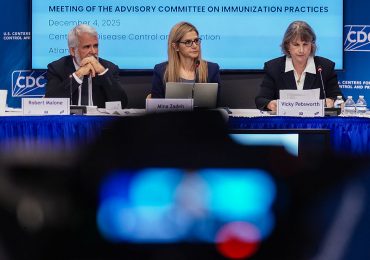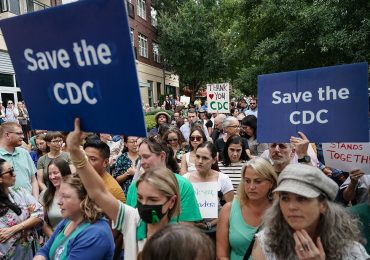Lowering cholesterol is one of the most effective ways to reduce your risk of heart disease, and it may soon be possible to get a one-and-done gene therapy to keep cholesterol and triglyceride levels down throughout your lifetime.
That’s the hope of a small new study led by Dr. Luke Laffin, a preventive cardiologist in the department of cardiovascular medicine at Cleveland Clinic, and senior investigator Dr. Steven Nissen, chair of cardiovascular medicine at Cleveland Clinic. In the trial, 15 people received the innovative gene therapy. All of the patients had high cholesterol, high triglycerides, or both, despite being treated with currently available medications, including statins. They received a one-time infusion of a CRISPR-based gene-editing therapy designed by CRISPR Therapeutics, a company that already has an approved CRISPR therapy to treat sickle-cell disease and a form of beta thalassemia. The participants received varying doses of the CRISPR therapy, since the early Phase 1 trial was designed to primarily evaluate whether the gene editing was safe and provide hints about its potential effectiveness.
[time-brightcove not-tgx=”true”]
Those who received the highest dose had a 50% decrease in their LDL, or bad cholesterol levels that can contribute to heart disease, compared to when they began the study, and a 55% drop in their triglyceride levels after six months.
“My view is that this is a very big deal,” says Nissen. “This is the first time anybody has ever edited a gene related to cholesterol metabolism and published results in a peer-reviewed journal. And the results are pretty spectacular.”
Read More: How to Lower Your Cholesterol Naturally
The treatment targets a gene called ANGPTL3, which scientists have previously found is mutated in people who have low cholesterol and triglyceride levels; this type of mutation seems to lower rates of heart disease, without being linked to other health issues. In people who don’t have the mutation, researchers speculate that disrupting this gene with CRISPR by cutting it makes it non-functional, potentially leading to lower cholesterol and triglyceride levels.
That’s what the Cleveland team saw in the first patients to receive the therapy. The CRISPR infusion included a package of genetic instructions, encased in a fat particle, that contained instructions to find liver cells where cholesterol is made. Inside the particle were a set of molecular scissors with specific genetic instructions to cut the ANGPTL3 gene.
By measuring the levels of the protein made by the gene in the blood, the researchers verified that the gene alteration was doing its job. “We confirmed there was less ANGPTL3 [protein] by knocking out the gene,” says Sam Kulkarni, CEO of CRISPR Therapeutics, which sponsored the study. “And it was in a nicely dose dependent fashion—the higher the dose went, the lower the levels of ANGPTL3 we were seeing.”
The research team sees several potential benefits in the CRISPR-based therapy over current treatments. Many people with high cholesterol levels, for example, rely on statins, but they have to take a pill every day. Studies have shown that about half of people who start statin therapy stop after a year because of side effects and difficulties with compliance. A more powerful way of addressing cholesterol involves another gene involved in cholesterol metabolism, PCSK9. The PCSK9 protein degrades the receptors that cells have for LDL, which is important for clearing LDL from the blood; inhibiting the protein allows more cells to retain the receptors and contributes to lowering LDL levels. There are several approved treatments that inhibit PCSK9 activity, but they require regular injections, and compliance can still be a challenge. Additionally, PCSK9 only addresses cholesterol, while ANGPTL3 reduces both LDL and triglycerides.
Read More: The Obscure Genetic Cholesterol That Can Impact Your Heart Health
Animal studies conducted by CRISPR Therapeutics show that monkeys treated with the gene editing kept their cholesterol and triglyceride levels low for two years; the current human study showed people were able to maintain lipid control for up to six months, and the company plans to follow them long term. (The FDA recommends, but does not require, 15 years of follow-up time for gene-editing therapies, including those involving CRISPR.)
CRISPR holds tremendous power to provide one-time treatments for gene-based conditions, but that potential also comes with risks. Intellia Therapeutics, which was studying a CRISPR treatment for a rare genetic heart condition, stopped its trial after participants developed severe liver toxicity.
Kulkarni says that not all CRISPR approaches are the same, with each company developing its own delivery and gene-editing package. “We have made improvements in all components of our CRISPR therapy,” he says. “And we have been absolutely thorough in making sure that there was no off-tissue editing and all of the editing happened in the liver and nowhere else, and that even in the liver, that we weren’t getting an edit where we shouldn’t.”
One participant in the current trial died six months after receiving the therapy, but Nissen says the patient had advanced atherosclerotic disease and “nobody involved thinks [the death] had anything to do with the therapy. Still, vigilance is required here. These are promising results, but [the therapy] needs to be studied in a larger patient population.”
Read More: How to Keep Your Heart Healthy in Your 20s, 30s, 40s, and Beyond
Both Kulkarni and the doctors involved in the study believe a broader population of people with high cholesterol and triglycerides could one day benefit from the CRISPR therapy. While the current study focused only on those who couldn’t control their lipids, the one-time gene editing could potentially be expanded to more people to help them control cholesterol and triglycerides and even protect them from having heart events. “If we have someone in their 30s or 40s with a severe family history of coronary disease, we know these patients may not be taking preventive therapies like statins, since we know 50% discontinue statins,” says Laffin. “If there is a one-and-done treatment that can lower their cholesterol over a lifetime, that would be a dream.”
Kulkarni says the company is planning to move into the next phase of studies with a larger group of patients, focusing first on those who have not responded to current lipid-lowering therapies, but eventually studying the therapy as a way to prevent heart disease in people who might be at higher risk but haven’t yet had any symptoms. “If you ask me where the world is 20 years from now, I see someone at high risk of heart disease who in their 30s has this gene-editing therapy so they don’t get heart disease in the future,” he says. “They won’t have to wait until they are 50 and have a heart attack to get this treatment. In some ways, cutting-edge CRISPR should actually be the first line of defense.”
If the results from the next phase of studies are as encouraging, a gene-editing therapy for controlling lipids may not be far off. “I can’t hold back my excitement over the ability to fix this gene and change lipids permanently,” says Nissen. “There are a lot of people out there we are just not able to fully treat. If we can do this once, then people will potentially have lifelong benefits.”
Leave a comment





